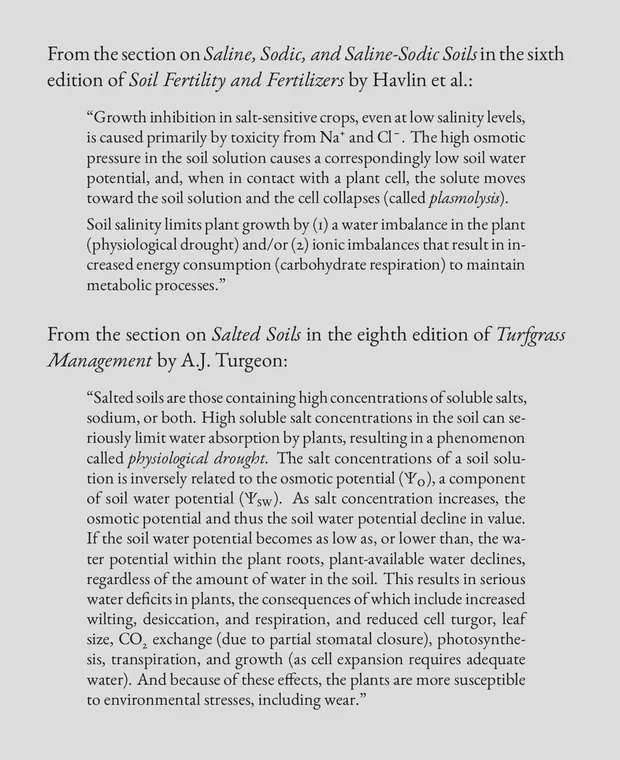It doesn't have to be so complicated
Three conversations about sodium, salt, and salinity
Irrigation water quality, salinity, gypsum, and sodium—I’m not even going to mention the problems that bicarbonate doesn’t cause—are topics that are sure to stir up some discussion.
I’m writing this to put links to a few old posts about sodium and salinity into one place, and to share excerpts from three recent conversations that might clarify some solutions, and the simplicity of the solutions, especially when dealing with turf growing in a sand rootzone.
3 articles about salinity and sodicity
- Is sodium an imaginary problem?
- Soil and water management: 3 problems, 3 solutions
- No matter how much sodium one puts into a sand rootzone, the soil structure cannot be affected, so gypsum won’t be required
From that last one, I wrote about how to classify the problems, and how to find the solutions for each one:
Real quick, water problems are divided into 3 main categories, and each has a different solution.
Salinity – this is the total salt. The solution to salinity problems is to add extra water to leach the salts below the rootzone. No Ca is required for this. The water does the leaching.
Sodicity – this is a soil structural problem that occurs in soils when the sodium gets too high. It is defined as exchangeable sodium percentage > 15%. This is irrelevant in sand rootzones because the sodium does not cause any structural problems in sand. This is a problem in clay soils. The solution to this problem is to add gypsum. The Ca in the gypsum then replaces some of the sodium and restores the soil structure.
Saline-Sodic – in this case, the sodicity occurs and is combined with high total salts. Also irrelevant in sand rootzones because of reason mentioned above. The solution to this problem is to add gypsum, to restore soil structure, and then to add extra water to leach the salts.
Three recent conversations
1. Sodium, sand, and gypsum
I’ve written that “No matter how much sodium one puts into a sand rootzone, the soil structure cannot be affected, so gypsum won’t be required.”
A correspondent asked, “Is it because the salt water passes thru rather than staying in the sand, i.e. no salt water no salt?
I wrote back, “Sodic soils have > 15% exchangeable sodium.
The reason for applying gypsum to sodic soils is to replace sodium on cation exchange sites with calcium, and from that process to reduce the exchangeable sodium percentage, improve the soil structure, and then be able to leach some of the sodium.
Sands don’t have any of these problems because the soil structure does not change no matter what type of sodium or salt is in the irrigation water or the soil. Thus, any salt can be leached simply by adding water, and there will be no improvement in soil structure, whether one adds gypsum or does not add gypsum.”
Take home message: understand the difference between salinity and sodicity, and apply that to water movement in sand rootzones.
2. Salinity confusion
A correspondent wrote, about Mehlich 3 soil test results, and how to apply the MLSN approach in this situation.
“Our sodium levels are on the high end at 30 ppm on average. Our irrigation water is extremely high in bi-carbs as well. K average [in the soil] is 64, Mg 160, Ca 1,627. So to combat the growing sodium levels do I just disregard our Ca numbers and push gypsum to flush Na out?”
I wrote back, “30 ppm sodium is what I would call normal. For all the putting green samples ATC has done in the past 12 years, the average is right around 30.
In fact, for a pushup green, with some soil in it, I would expect even more sodium. For cool season grass, with the Mehlich 3 extractant, I would want the sodium to be less than 110 ppm.
I’m not worried about bicarbonate in irrigation water. The thing to be concerned about in the irrigation water is the EC or the TDS. Those are the measure of the total amount of salt.
In a sand rootzone, you can leach sodium (and other salts) without gypsum.
I expect you can proceed without any gypsum applications. I wouldn’t recommend any based on those results.”
My correspondent wrote back with more information: “Our EC is 0.58 [dS/m] and TDS [total dissolved solids] is 390 [ppm].”
I concluded with this: “Those are negligible salt levels. I’d worry about total water content in the soil. Keep that in the optimum range for your turf and you should be fine.”
See Harivandi’s Interpreting Turfgrass Irrigation Water Test Results for more details. Water with that much salt is classified as Degree of restriction on use: none.
Take home message: understand threshold salinity levels that might cause problems, and stay safely away from them.
3. Salt and physiological drought
Tom Calder asked, “if we do have salts in our soils, is the concern/problem more about the salts almost stealing the water from the plant like a sponge?”
That’s kind of the problem, although I like to think of it more in terms of salinity reduces the availability of water to the grass, and because of that it reduces the growth rate of the grass. Here are two technical descriptions of this from textbooks:

Take home message: understand what salinity does, and (going back to the point I made above), be sure to know the difference between salinity and sodicity.